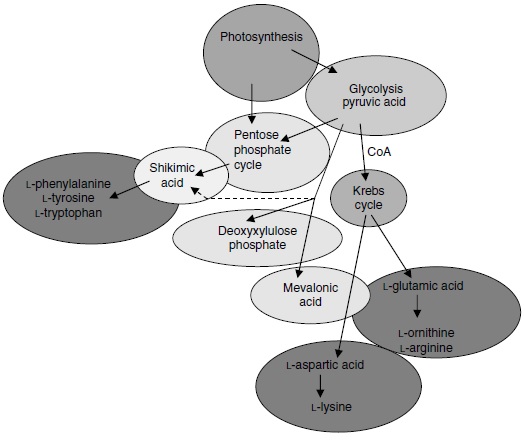If we want to look at ways to increase alkaloid production in plants, it makes sense that an approach could be to increase the materials the plant uses to synthesize DMT, or to enhance the metabolic process.
To do so, we need to take a closer look at understanding alkaloid synthesis and it's metabolism... I will keep it simplified in laymans terms.
The process that leads up to the synthesis of N,N-dimethyltryptamine (DMT) basically goes like this:
Shikimic acid >
L-Typtophan >
Tryptamine >
NMT/DMTThe question of "How to increase DMT?" seems to be preceeded by the following questions:
How do we increase Tryptamines?
How do we increase L-Tryptophan?
How do we increase Shikimic acid?
So, lets start at the beginning...

1)
Shikimic acid Shikimic acid is made via the "pentose phosphate cycle".
It mainly comes directly from photosynthesis or from glycolysis (preceded by photosynthesis).
It can also come from pyruvic acid (which is made from glucose thru glycolysis).
The shikimic acid concentration in plant organs is not constant and depends on the synthesis rate of aromatic amino acids. It accumulates in those tissues wherein the metabolic processes are stopped or slow, such as storage tissue of seeds and fruits.
Glyphosate can be used to increase shikimic acid, but it does this by inhibiting the shikimic acid pathway (specifically the enzyme
5-enolpyruvoylshikimate 3-phosphate synthetase), but we don't want to inhibit this pathway, we wan to catalyze it. Enzymatic activity is markedly influenced by elements such as potassium or ammonium.
Obviously more light can enhance photosynthesis, but how else can we optimize the "
penthose phosphate pathway"?
Glucose-6-phosphate dehydrogenase (
G6PDH) is the rate-controlling enzyme of the "penthose phosphate pathway"
It would be worth looking at how to increase
G6PDH.
2)
L-TryptophanL-Tryptophan is synthesize by the Shikimate pathway, which involves quite a few steps I won't go into for simplicity sake.
It
can be externally applied to plant soil, which has shown in studies to increase uptake of nitrogen, phosphorus and potassium, resulting in increased plant growth.
Another thing is smoke/ash water which contains
karrikinolide and
gibberellic acid.
When used on plants,
gibberellic acid:
* produces bigger leaves and longer stems.
*
enhances photosynthesis.* stimulate seed germination.
* trigger transitions from the vegetative to the flowering stage.
In some studies, the rate of tryptophan metabolism in the presence of
gibberellic acid was
increased by 100%!
Note: Anthranilic acid is also a precursor to L-Tryptophan via a different pathway, by attaching phosphoribosyl pyrophosphate to the amine group.
Maybe there is a way to increase phosphoribosylpyrophosphate synthetase activity in plants, which has been show to increase biomass in some studies. Hmmm....
3)
TryptamineL-Tryptophan converts into
tryptamine by "decarboxylation" (ie "removing a carbon atom from the chain" )
This process is mediated by an enzyme called "
L-tryptophan decarboxylase", also known as "
Aromatic L-amino acid decarboxylase" (AADC).
The enzyme uses
pyridoxal phosphate, the active form of
vitamin B6, as a cofactor.
So maybe supplementing with
vitamin B6 will help?
4)
NMT/DMTTryptamine undergoes a process called "transmethylation" (ie "transfer of a methyl group" ) which produced
N-methyltryptamine (NMT). NMT then gets transmethylated by the same process to produce
N,N-dimethyltryptamine (DMT).
An enzyme called "indolethylamine-N-methyltransferase" (INMT) catalyzes the transfer of the methyl group from cofactor S-adenosyl-methionine (SAM), via nucleophilic attrachment, to tryptamine.
A few notes on Nitrogen:Higher leaf alkaloid content is thought to result from higher nitrogen and cation availability.
It does seem that alkaloid content is generally related to nitrogen levels available to plants.
Two basic factors seem to influence this relation:
(1) the biosynthetic nature of alkaloids themselves, and
(2) the balance of nitrogen and other nutrients in the soil.
The alkaloid biosynthetic pathway is important in this sense that during synthesis the nitrogen existing in the precursor can be liberated, or additional nitrogen may bind.
High or low concentrations of nitrogen in soil seem to influence alkaloid content in the plant despite the biosynthetic nature of alkaloids.
In both mentioned cases, the plant suffers from nutritional stress and the production of alkaloids seems to increase.
Nutritional stress is affected by absences and a high demand for nitrogen during metabolism. Plant stress in this sense can be determined as a force which strengthens alkaloid production for both continuing storage in vacuoles and for continuing their departure from vacuoles for the metabolic regulation of stress.
Soil acidity and temporary drought stress are also known to block nitrification and may contribute to low leaf alkaloid accumulation.
Throughout recorded time and long before, trees have stood as sentinels, wise yet silent, patiently accumulating their rings while the storms of history have raged around them --The living wisdom of trees, Fred Hageneder